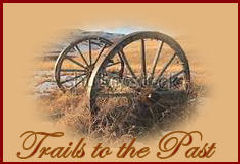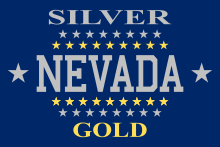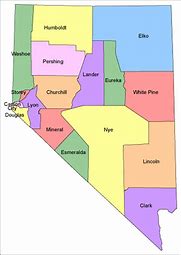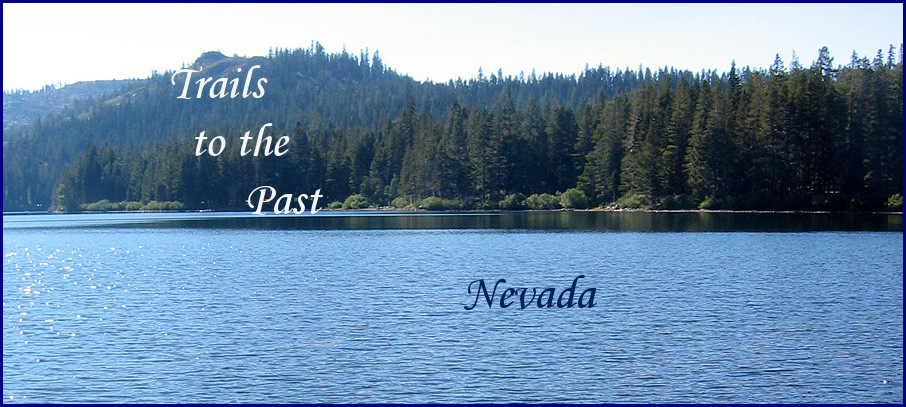 |
Nevada became the 36th
State
on October 31,
1864 |
 |
Trails to
the Past of Nevada is accepting any donations of
genealogy materials that you may have such as marriage
announcements, news articles, old obituaries, births,
(you do not need the birth certificate) just the
information, and biographies. If you have any of
these items please contact me Marie Miller the Nevada State
Administrator.
Nevada became the 36th state
on October 31, 1864, after telegraphing the Constitution
of Nevada to the Congress days before the November 8
presidential election (the largest and costliest
transmission ever by telegraph). Statehood was rushed to
help ensure three electoral votes for Abraham Lincoln's
reelection and add to the Republican congressional
majorities
Nevada's harsh but rich
environment shaped its history and culture. Before 1858
small Mormon settlements existed along the border of
Utah, with the western part stumbling along until the
great silver strikes beginning in 1858 created boom
towns and fabulous fortunes. After the beginning of the
20th century, profits declined while Progressive
reformers sought to curb capitalism. They imagined a
civilized Nevada of universities, lofty idealism, and
social reform. But an economic bust during the 1910s and
disillusionment from failures at social reform and a
population decline of nearly one-fourth meant that by
1920 Nevada had degenerated into a "beautiful desert of
buried hopes."
The 1859 Comstock
Lode discovery opened the era of silver mining in
Nevada, and attracted thousands of miners-most from
California. It was discovered by James Finney in Carson
County. Disputes over the legal limits of a claim soon
went to court, as the Law of the Apex, used to determine
those limits, was unworkable for the deep ore bodies in
the Comstock. The legal and judicial system of Carson
County was unprepared for the tremendous demands placed
on it. Judges were underpaid and underqualified, bribery
of witnesses and jurors was commonplace, vague
record-keeping created nearly insurmountable
difficulties with property titles, and evidence was
often destroyed. Though workable mining laws still were
needed, the resignation of the entire territorial
supreme court in 1864 did cause litigation to stop and
allowed mining work to resume.There was a gold rush that
created Aurora in (1860). Located on the disputed border
with California, at one time Aurora was the county seat
of counties in California and Nevada, until the boundary
dispute was settled locating Aurora in
Nevada.
The 1867 expansion of the
state's southern boundary was prompted by the discovery
of gold in the area since officials thought Nevada would
be better able to oversee the expected gold rush. By
1872, Nevada mining was an industry of speculation and
immense wealth. After 1870, however, the mining industry
went into eclipse, as the state's Silverite politicians
worked to secure laws to require the federal government
to purchase silver.
The
discovery of silver and gold in 1910 near Tonopah set
off a boom that ended Nevada's Economic
depression.
The operators used the
best available technology to recover gold and silver
from ore, but by modern standards there was much
inefficiency and chemical pollution. Methods included
the use of the arrastra, the patio process, the Freiberg
process, and the Washoe pan process. Estimates of value
lost through recovery processes ran as high as 25%. Mine
operators sought improved technology, but were unwilling
to wait years or decades for it to arrive. No one at the
time understood the health problems such metals as
mercury could cause.
In the 1770s,
Franciscan missionary Francisco Garcés, born in Morata
del Conde, Aragon, Spain in 1738, was the first European
in the area.[8] Nevada was annexed as a part of the
Spanish Empire in the northwestern territory of New
Spain. Administratively, the area of Nevada was part of
the Commandancy General of the Provincias Internas in
the Viceroyalty of New Spain. Nevada became a part of
Alta California (Upper California) province in 1804 when
the Californias were split. With the Mexican War of
Independence won in 1821, the province of Alta
California became a territory-not a state-of Mexico, due
to the small population. In later years, a desire for
increased autonomy led to several attempts by the Alta
Californians to gain independence from
Mexico.
Jedediah Smith entered the Las Vegas Valley in
1827, and Peter Skene Ogden traveled the Humboldt River
in 1828. As a result of the Mexican-American War and the
Treaty of Guadalupe Hidalgo, Mexico permanently lost
Alta California in 1848. The new areas acquired by the
United States continued to be administered as
territories. As part of the Mexican Cession (1848) and
the subsequent California Gold Rush that used Emigrant
Trails through the area, the state's area evolved first
as part of the Utah Territory, then the Nevada Territory
(March 2, 1861; named for the Sierra
Nevada)
Nevada became part of the
United States with the Treaty of Guadalupe Hidalgo with
Mexico in 1848. Mexico had never established any control
in Nevada, but American mountain men were in Washoe (the
early name for Nevada) as early as 1827. A permanent
American presence began in 1851 when the Mormons set up
way stations en route to the California gold fields. In
the absence of any governmental authority, some 50
Mormons and non-Mormon prospectors and cattle ranchers
drew up the "Washoe code" to deal with land claims; its
coverage eventually covered other governmental issues.
There still was no federal presence in the area so
religious tensions worsened and petitions of complaint
went to Washington. Non-Mormons sought annexation to
California. Utah Territory countered this by
incorporating the area as a county. When Federal troops
were sent to Utah in 1857, the Mormons left Washoe. The
non-Mormons took over and launched a move for separate
territorial status.
The early 1860s
saw the end of an Indian war, the great Comstock mining
boom of 1859 in Virginia City and the coming of the
Civil War. The provisional territorial government led to
the creation of Nevada Territory by Congress in 1861.
The pragmatic attempts to establish workable frontier
institutions had failed and the paternalistic
territorial system was welcomed.
The University of Nevada
was founded in Elko in 1874 and moved to Reno in
1885
.
Although the
transcontinental railroad crossed the state in 1869,
most town and mines were remote from it and required a
network of wagon freight and stagecoaches. Numerous
small companies supplied the horses, mules, and wagons
for hauling borax and silver ore. Stagecoaches were
notoriously uncomfortable across the roadless land, but
were better than the alternatives and flourished until a
railroad finally arrived. Hold-ups were rare, and
usually involved petty theft since armed guards were an
effective deterrent. Mail contracts kept stage lines
afloat and allowed the emergence of a class of
entrepreneurs who won contracts and subcontracted the
actual work.
The Eureka and Palisade Railroad was a
narrow-gauge railroad ninety miles long built in 1875 to
carry silver-lead ore from Eureka, Nevada, to the
Southern Pacific Railroad trunk line that ran through
Palisade. Nevertheless, despite the determined and
colorful management style of John Sexton, the line
succumbed to the effects of flood, fire, competing road
traffic, and dwindling amounts of ore extracted in
Eureka. The rails and rolling stock of the last
surviving narrow-gauge railroad in Nevada were removed
in 1938.
Crimes These also give the
name of the victim, so if you have an ancestor that is
just missing be sure to look here. I also have all
the crimes listed in each county under the News
section.
Nevada Counties

| County | County Seat | Established | Origin | Origin of Name |
| Carson
City | Independent City | 1969 | Founded in 1858, consolidated with ormsby county in 1969 | Carson River named for Christopher Houston (Kit) Carson (1809-1868) the frontier scout and soldier. |
| Churchill | Fallon | 1861 | Original | Sylvester Churchill (1783-1862) a general in the Mexican-American War |
| Clark | Las Vegas | 1909 | Lincoln County | William A. Clark (1839-1925), former United States Senator from Montana, and builder of a railroad line through the area. |
| Douglas |
Minden | 1861 | Original | Steven Arnold Douglas (1813-1861), former United States Senator from Illinois. |
| Elko | Elko | 1869 | Lander County | A Shoshoni word meaning white woman. It is said, among the very old Shoshoni, that this is where they first saw a white woman. |
| Esmeralda | Goldfield | 1861 | Original | Esmeralda Mining District, named in turn for the legend that a massive amount of emeralds was buried in what is now Nevada. Esmeralda is the Spanish and Portuguese word for emerald. |
| Eureka | Eureka | 1873 | Lander County | Greek expression Eureka,meaning I have found it! In reference to deposits of silver found in the vincinity |
| Humboldt | Winnemucca | 1861 | Original | Humboldt River named in turn for Alexander Humboldt (1769-1859) a German explorer. |
| Lander | Battle Mountain | 1861 | Original | Fredrick W. Lander (1821-1862) an American Civil War general and developer of the area. |
| Lincoln | Pioche | 1866 | Nye County and territory ceded by Arizona | Abraham Lincoln (1809-1865) the sixteenth President of the United States. |
| Lyon | Yerington | 1861 | Original | General Nathaniel Lyon (1818-1861) who was killed in action at the Battle of Wilsons Creek. |
| Mineral | Hawthorne | 1911 | Esmeralda County | Mineral deposits in the area. |
|
Nye
| Tonopah | 1864 | Esmeralda County | James W. Nye (1815-1876) a governor of the Nevada Territory and U. S. senator from Nevada. |
| Pershing | Lovelock | 1919 | Humboldt County | John Joseph (Black Jack) Pershing (1860-1948) the World War I general |
| Storey | Virginia City | 1861 | Original | Edward Farris Storey (1829-1860) a captain killed at Pyramid Lake in the 1860 Paiute War. |
| Washoe | Reno | 1861 | Original | The Washo a small Indian tribe that inhabits the area. |
| White
Pine | Ely | 1869 | Lander County | Heavy growth of pine trees in the area, thought to be white pine. |
The information on Trails to
the Past © Copyright
may be used in personal family history research, with
source citation. The pages in entirety may not be
duplicated for publication in any fashion without the
permission of the owner. Commercial use of any material
on this site is not permitted. Please respect the
wishes of those who have contributed their time and
efforts to make this free site possible.~Thank
you!
|

